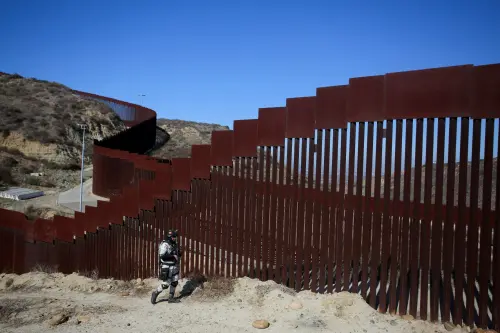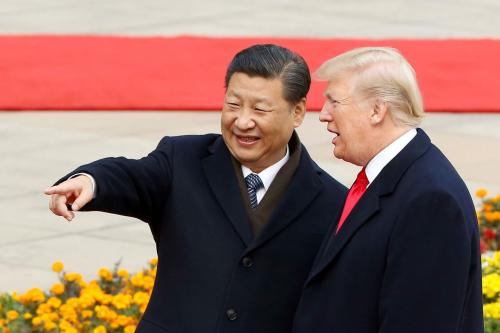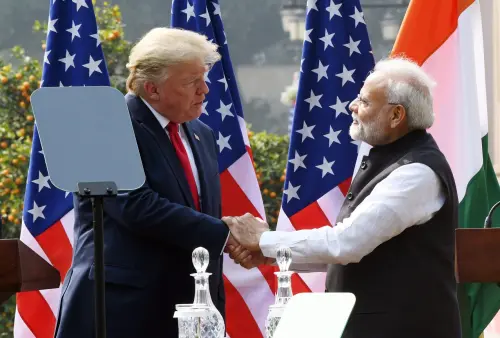Introduction
Thank you for the invitation to appear before the Subcommittee to discuss U.S. assistance programs for democracy managed by the State Department; the role of the annual human rights reports in formulating assistance strategies; and, as a case study, U.S. programs to promote greater openness in China. My views are informed by my experience as Deputy Assistant Secretary of State in the Bureau of Democracy, Human Rights and Labor from 1993 to 1997, and by my research on recent political change in China at the Brookings Institution.
Since 1989, China’s human rights record and its political system have been the subject of polarized debate in the U.S. policy community. This has complicated (and sometimes prevented) attempts to formulate official policy to support emerging trends in China which could help build the scaffolding for greater protection of rights and, over time, promote greater political openness. The reasons for this are numerous: opposing views on the likely path of political change in China; disagreement over the policy instruments most appropriate to encouraging change; significant problems in the overall U.S.-China relationship; and the legal and bureaucratic obstacles to funding and implementing programs in China. Attempts by the State Department’s Bureau of Democracy, Human Rights and Labor (DRL) to launch a modest assistance effort for China since 1995, in support of broader U.S. policy to promote human rights in that country, have been subject to these various issues.
This experience has also laid bare the difficulties encountered by a bureau whose primary responsibility has been monitoring the daily status of human rights on a global basis in developing a long-term vision and strategy for encouraging political and social change in a specific country, indeed the most populous country of the world and arguably one of the most complicated ones. Assistance programs for China should be rooted in a long-term as well as shorter perspective. However, DRL, and the State Department on the whole, are often forced to pursue a “fire engine” approach to human rights policy, focusing on large-scale abuses or new incidents of repression in target countries. This leaves little time or personnel to note or encourage more subtle trends which, over time, could become the basis for a more open system, or which mark a new direction in citizen-state relations.
A complicating factor for U.S. human rights policy in China, and more narrowly for assistance programs to China, is the complex and sometimes contradictory nature of Chinese political development. A step toward a more liberal environment is often matched by a step backward. In a country as large as China, it can be difficult to discern a clear bottom line when both positive and negative trends are simultaneously in play.
This difficulty is exacerbated by the expectations for political change held by many Americans in the wake of the Soviet Union’s collapse, and by the perception that democratization is an imminent and inevitable trend—in the phrase coined by Harvard Professor Samuel Huntingon, a “wave”—sweeping the world. It is incontrovertible that several new democracies have arisen in the past twenty years. It is also obvious that some of these new democratic systems are experiencing backsliding and other problems which demonstrate the difficulties of moving away from authoritarian rule. However, the popular perception of an era of democratic revolutions, indeed of “pop-up” democracies, has built a great deal of impatience into policies toward the remaining authoritarian societies. In the extreme version of this view, the best policy measures—indeed, the only credible ones—are those which promise to deliver authoritarian regimes to democracy’s door. Not surprisingly, such policies are in short supply.
This perspective has also encouraged a monolithic view of countries which remain under authoritarian rule. Too often, there is little effort to distinguish between the political systems and the prospects for change among countries on the repressive end of the spectrum. There is evidence, for example, that China’s experiments in legal reform and its relaxation of social controls, although limited, are more advanced and more vigorous than those in Vietnam, Laos, Cuba, North Korea and Burma. (In fact, some of the countries in the latter group cannot be said to be contemplating, much less implementing, any reforms of this nature.) This monolithic view has encouraged a single formula for a human rights policy toward all authoritarian countries. With our former cold war adversaries in particular, that formula is based on factors which led to the demise of communist rule in the former Soviet bloc (or those factors which we believe contributed to that end), and on U.S. efforts to promote human rights and democracy in that region during the cold war.
In this policy environment, it has been difficult to gain broad support for programs which seek to build on positive trends in China, even if the larger portion of our human rights policy continues to focus on areas of repression. And, not surprisingly, initial efforts to inaugurate an official assistance program for China mirror some elements of U.S. policy toward the former Soviet bloc. The emphasis on dissidents outside of China; the prohibition against working with Chinese government agencies, even with reformers within those agencies; and the insistence on funding groups whose stated purpose is to democratize China are all borrowed from the cold war era.
At this juncture in China’s political development, it is more appropriate to support programs which build upon existing trends and which encourage political liberalization—defined as promoting more open and responsive government, and greater voice for citizens in both public policy and in civil affairs—but does not demand a specific level of democratization. Such an approach may, paradoxically, be the shorter and the surer path toward encouraging eventual democratization in China. However, crafting such a program requires a clear-headed assessment of present realities in China, both positive and negative, and some adjustment in both our policy approach and our policy instruments.
Toward a More Effective Approach
In making such a paradigm shift, it is not necessary to design an approach to promoting political change in China out of whole cloth. Although the issue of official U.S. assistance to China is relatively new, and somewhat contentious, American non-governmental efforts to support Chinese trends in political development, as opportunities present themselves, have been ongoing since 1979. Using U.S. Government funds appropriated to them through general grants, or relying upon private support, a small group of American non-governmental organizations have worked steadily and productively with Chinese universities, think tanks, civic organizations and government entities on a widening range of issues. The most experienced of these organizations include The Asia Foundation—which presently works in the areas of Chinese legal reform; local governance; nonprofit sector development; and economic reform—and the Ford Foundation, whose current programs in China aim to strengthen government accountability and support the development of social organizations. A number of other American NGO’s have mounted smaller efforts in China, in fields such as legal training, but have accumulated valuable experience.
The relative success of such NGO’s—in being able to work in cutting-edge and sensitive areas of Chinese social and political development—can be attributed to their operating philosophies. These groups have gained the confidence of a variety of Chinese governmental and non-governmental actors; have followed an incremental approach to encouraging change; and, perhaps most important, have been well-positioned to identify and support indigenous initiatives. The experience of these organizations is instructive in building an official assistance program for China, and serves as an important backdrop. Equally important, an official assistance program for China should seek to work with American organizations which bring to the table expertise and experience with China. This goes against the current preference for offshore, “parachute” organizations which field consultants who might offer useful technical advice, but which are not in a position to assess the impact of those consultancies or to support follow-up activities. It is not a coincidence that some of the most effective American NGO’s working in China have offices in Beijing or Hong Kong, and employ respected Chinese senior staff in those offices.
- Beyond the choice of partners, a program designed to support liberalization in China at the present time should consider the following:
- Utilizing a more instrumental and a less ideological approach. U.S. human rights policy in China has tended to focus on individuals and groups which challenge the political authority of the current regime, and which function as a would-be opposition force, because they tend to be the greatest targets of government censure and repression. This is a natural concern for our human rights diplomacy, but this focus does not necessarily translate into an effective assistance policy. At the present time, programs should concentrate on sectors where freedoms are emerging or being enlarged, rather than on simply the most confrontational forces. In China, many citizens are focusing not on the political form of their government but on whether or not their government is effective and accountable. Groups which lobby for improved social services or better environmental protection are often able to gain access and exert influence on policymakers more readily than those who call for a formal change of government. They are sometimes able to mine areas of “accidental openness” not available to actors with declared agendas of political opposition.
- Refraining from demanding a strict separation between state and society, policymakers often place more stringent demands upon the institutions in an authoritarian system than on those in democratizing societies, where institutional amphibiousness may also linger. In the liberalization (as distinct from democratization) phase, external donors should expect to encounter (and work with) state institutions under the influence of the regime and social organizations with links to the government. Indeed, even in established democracies there are considerable “grey areas” between state and society, but because of the strength of democratic institutions in these countries, we tend not to be alarmed by those blurred distinctions. In the wake of the “people’s power” revolutions of the 1980’s, some Americans assume that the only route to political change in authoritarian states is one in which a confrontational civil society agitates for a change in the political system through relentless protest and other opposition. Although this is a favored model in some policy circles, in reality it is a rare one. In the majority of countries which have moved away from authoritarianism, political change has been a matter of long-term negotiation, within regimes and between state and society.
In present-day China, an assistance program should seek to encourage greater pluralism in both state and society, rather than in attempting to force a strict separation between the two. This could translate into helping social organizations gain greater competence for self-rule, even if they remain under some governmental controls, or aiding government ministries charged with implementing more liberal reforms. The latter also enables external donors to support moderates and reformers within the government, without intruding into the political process in a way which could be counter-productive.
- Employing regional strategies where possible and appropriate. A decade of rhetorical battle between the United States and China has left many Chinese, even ordinary ones, with the impression that U.S. policy seeks to impose American political models onto China. As other Asian countries continue to make democratic strides, opportunities are expanding to encourage regional dialogue on political change and to reverse the impression that more open social and political institutions are necessarily Western imports. In the case of China, there is added impetus to encourage regional dialogue on political and social reform, because such issues increasingly affect the mainland’s relations with Hong Kong and, of course, with Taiwan. These dialogues should be promoted in a low-key and cautious manner, preferably through American non-governmental groups. One notable example is the Elizabeth Luce Moore Leadership Program for Chinese Women, sponsored by the Institute for International Education and funded by the Henry Luce Foundation, which brings together women leaders of non-governmental and community groups from the mainland, Hong Kong and Taiwan with their American counterparts. Such programs help to build networks within key sectors in Asian countries, and reinforce momentum for reform.
Official Assistance: State or USAID?
Given the delicate and sometimes daunting task of crafting appropriate strategies to promote political liberalization in China, it is tempting to conclude that there is little role for U.S. assistance at this stage in China’s political development, and at this juncture in U.S.-China relations. Although American NGO’s will continue to be key players in the effort to encourage political change in China, there are arguments for a prudent U.S. Government program. Given the close attention that the United States gives to China’s human rights abuses, refusal to assist positive trends toward greater openness gives our human rights policy a disingenuous tone. This perception has intensified in the wake of the 1997-98 U.S.-China Summits, at which time the two governments agreed to cooperate on promoting the rule of law in China. Beyond this consideration, and perhaps more important, opportunities for external assistance to China’s legal and social reform are outpacing foundation and corporate funds available for this purpose.
However, there is presently no clear bureaucratic fit within the U.S. Government for an assistance program to promote liberalization in China. The United States Agency for International Development has no activities in China, nor is it likely to in the immediate future. At this point in time, China does not fit USAID’s criteria for a “sustainable development” country, which includes a formal commitment to democracy on the part of the government. For these reasons, as well as to ensure that programs are consonant with our broader human rights policy for China, oversight and implementation of China programs has fallen primarily to the State Department’s Bureau of Democracy, Human Rights and Labor. This has proved to be problematic, since the great majority of State Department officials and foreign service officers have little or no grounding in program development or program management. If DRL continues to administer assistance programs, this deficit should be addressed through recruitment of civil service officers with such training, or by training existing staff to ensure that program management functions are adequately covered.
Using the Human Rights Reports
A final issue attendant the subject of DRL-managed programs is the application of the annual human rights reporting process to assistance programs with China and other countries under authoritarian rule. Overall, the reports are structured to provide critical information to policymakers, but not to shape policy itself. In my view, the Department has been correct in resisting occasional external pressure to describe and evaluate U.S. human rights policy as part of the reporting process. That would risk politicizing the reports, or encourage reporting that supports a particular policy. However, if the reports are to be more useful to assistance programs in authoritarian countries, they should devote greater attention to institutional reform and trends in state-societal relations. At this time, the human rights reports tend to focus on and document human rights abuse in quantifiable measures, but they frequently skim over, or omit altogether, reporting on more subtle but potentially important attitudinal changes. Without an expanded view, the human rights reports provide an implicit series of benchmarks for countries such as China which do not adequately describe or assess the prospects for political and social reform, or the difficulties of such reform. Just as our view of change in countries such as China should be broadened, so should our instruments for measuring this change.
Thank you for the invitation to appear before the Subcommittee to discuss U.S. assistance programs for democracy managed by the State Department; the role of the annual human rights reports in formulating assistance strategies; and, as a case study, U.S. programs to promote greater openness in China. My views are informed by my experience as Deputy Assistant Secretary of State in the Bureau of Democracy, Human Rights and Labor from 1993 to 1997, and by my research on recent political change in China at the Brookings Institution
Thank you for the invitation to appear before the Subcommittee to discuss U.S. assistance programs for democracy managed by the State Department; the role of the annual human rights reports in formulating assistance strategies; and, as a case study, U.S. programs to promote greater openness in China. My views are informed by my experience as Deputy Assistant Secretary of State in the Bureau of Democracy, Human Rights and Labor from 1993 to 1997, and by my research on recent political change in China at the Brookings Institution
Thank you for the invitation to appear before the Subcommittee to discuss U.S. assistance programs for democracy managed by the State Department; the role of the annual human rights reports in formulating assistance strategies; and, as a case study, U.S. programs to promote greater openness in China. My views are informed by my experience as Deputy Assistant Secretary of State in the Bureau of Democracy, Human Rights and Labor from 1993 to 1997, and by my research on recent political change in China at the Brookings Institution
The Brookings Institution is committed to quality, independence, and impact.
We are supported by a diverse array of funders. In line with our values and policies, each Brookings publication represents the sole views of its author(s).



Commentary
TestimonySupporting Political Liberalization in China: The Role of the United States
March 7, 2001